assignment | ELECTRICAL GENERATOR FOR WIND ENERGY BY USING HORIZONTAL WIND TURBINE
Abstract: A short descriptive summary of the thesis on the topic of electrical generator for wind energy using horizontal wind turbine.
48 Pages9062 Words32 Views
Added on 2022-09-30
assignment | ELECTRICAL GENERATOR FOR WIND ENERGY BY USING HORIZONTAL WIND TURBINE
Abstract: A short descriptive summary of the thesis on the topic of electrical generator for wind energy using horizontal wind turbine.
Added on 2022-09-30
ShareRelated Documents
GENERATION OF WIND POWER
ELECTRICAL GENERATOR FOR WIND ENERGY BY USING HORIZONTAL
WIND TURBINE
By Name
Institution affiliation
Name
Course
ELECTRICAL GENERATOR FOR WIND ENERGY BY USING HORIZONTAL
WIND TURBINE
By Name
Institution affiliation
Name
Course
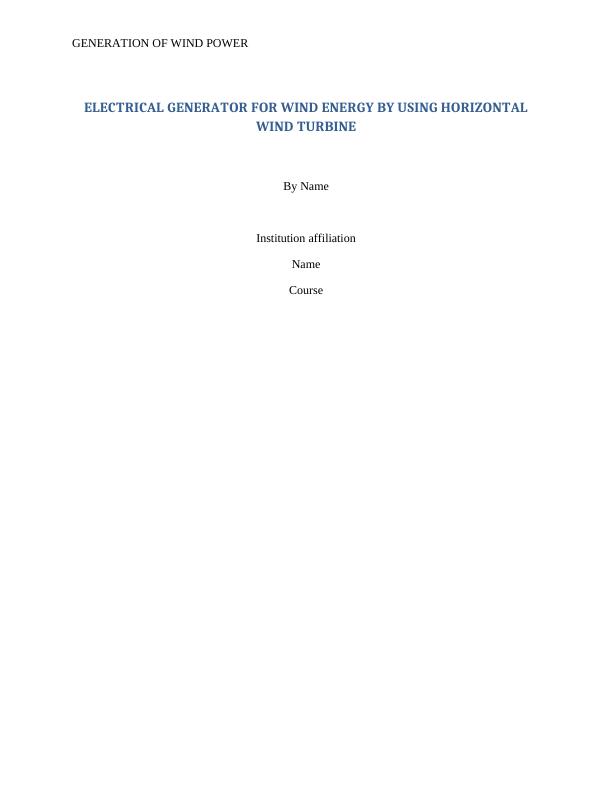
GENERATION OF WIND POWER
Table of Contents
ELECTRICAL GENERATOR FOR WIND ENERGY BY USING HORIZONTAL WIND TURBINE..............................1
ABSTRACT....................................................................................................................................................2
CHAPTER 1: INTRODUCTION........................................................................................................................4
CHAPTER 2: LITERATURE REVIEW................................................................................................................9
Wind Turbines.........................................................................................................................................9
Horizontal Axis Wind Turbines (HAWT)...................................................................................................9
Advantages of Horizontal Axis Wind Turbine....................................................................................11
Disadvantages of Horizontal Axis Wind Turbine................................................................................11
Vertical Axis Wind Turbine (VAWT).......................................................................................................11
Advantages of Vertical Axis Wind Turbine.........................................................................................12
Disadvantages of Vertical Axis Wind Turbine....................................................................................13
Controllers.............................................................................................................................................14
Power control....................................................................................................................................14
Stall....................................................................................................................................................15
Pitch control......................................................................................................................................15
Yawing (stopping)..................................................................................................................................16
Electrical breaking.................................................................................................................................16
Mechanical braking...............................................................................................................................16
Generators.............................................................................................................................................16
Synchronous generator.....................................................................................................................17
Asynchronous generator...................................................................................................................18
Squirrel cage induction generator (SCIG)...........................................................................................18
Doubly fed induction generator (DFIG)..............................................................................................19
Operation of a wind turbine connected with a double fed induction generator...................................19
Requirements of the grid connection................................................................................................20
Table of Contents
ELECTRICAL GENERATOR FOR WIND ENERGY BY USING HORIZONTAL WIND TURBINE..............................1
ABSTRACT....................................................................................................................................................2
CHAPTER 1: INTRODUCTION........................................................................................................................4
CHAPTER 2: LITERATURE REVIEW................................................................................................................9
Wind Turbines.........................................................................................................................................9
Horizontal Axis Wind Turbines (HAWT)...................................................................................................9
Advantages of Horizontal Axis Wind Turbine....................................................................................11
Disadvantages of Horizontal Axis Wind Turbine................................................................................11
Vertical Axis Wind Turbine (VAWT).......................................................................................................11
Advantages of Vertical Axis Wind Turbine.........................................................................................12
Disadvantages of Vertical Axis Wind Turbine....................................................................................13
Controllers.............................................................................................................................................14
Power control....................................................................................................................................14
Stall....................................................................................................................................................15
Pitch control......................................................................................................................................15
Yawing (stopping)..................................................................................................................................16
Electrical breaking.................................................................................................................................16
Mechanical braking...............................................................................................................................16
Generators.............................................................................................................................................16
Synchronous generator.....................................................................................................................17
Asynchronous generator...................................................................................................................18
Squirrel cage induction generator (SCIG)...........................................................................................18
Doubly fed induction generator (DFIG)..............................................................................................19
Operation of a wind turbine connected with a double fed induction generator...................................19
Requirements of the grid connection................................................................................................20
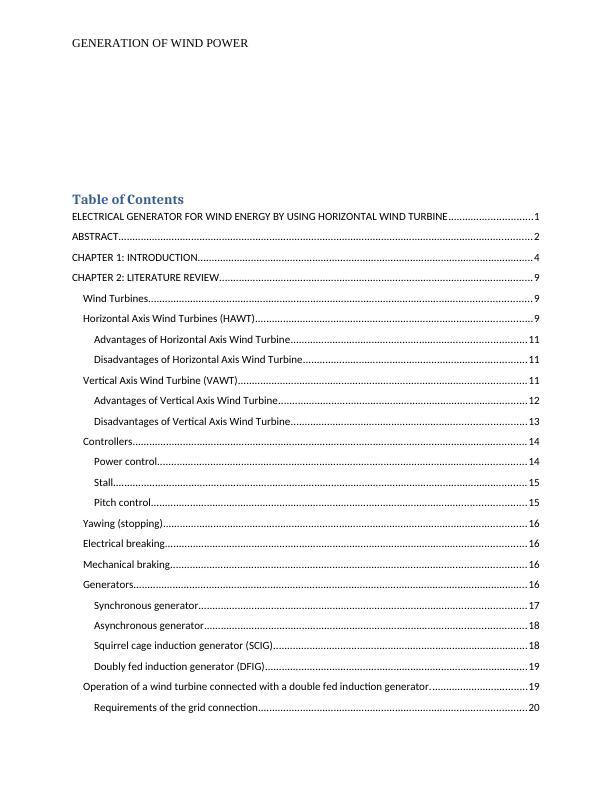
GENERATION OF WIND POWER
Control of the reactive power...............................................................................................................21
Controlled power and the range of frequency......................................................................................21
Power factor and the controlled voltage...............................................................................................21
A.C generation using a variable frequency............................................................................................22
Alternating current to direct current.................................................................................................23
Changing to ac of fixed frequency.....................................................................................................23
AC filtering.........................................................................................................................................23
Benefits of grid indirect connection using variable speed.................................................................23
Limitations of grid indirect connection..............................................................................................23
CHAPTER 3: METHODOLOGY.....................................................................................................................25
Multi generator for the windmill...........................................................................................................25
The methods’ principle......................................................................................................................25
Methods’ construction......................................................................................................................25
Generators poles...................................................................................................................................27
Operation of the method...................................................................................................................28
Transmission of power and torque within bevel and spur gear............................................................28
Methods advantages.........................................................................................................................30
Disadvantage of the methods............................................................................................................30
CHAPTER 4: DESIGN AND THE RESULTS OF THE PROJECT.........................................................................31
Model description.................................................................................................................................31
Internal structure of the model.............................................................................................................32
Air foil................................................................................................................................................33
Specifications.....................................................................................................................................35
CHAPTER 5: SUMMARY AND WORK PLAN.................................................................................................40
Project work plan..................................................................................................................................40
Conclusion.............................................................................................................................................41
Reference..................................................................................................................................................42
Control of the reactive power...............................................................................................................21
Controlled power and the range of frequency......................................................................................21
Power factor and the controlled voltage...............................................................................................21
A.C generation using a variable frequency............................................................................................22
Alternating current to direct current.................................................................................................23
Changing to ac of fixed frequency.....................................................................................................23
AC filtering.........................................................................................................................................23
Benefits of grid indirect connection using variable speed.................................................................23
Limitations of grid indirect connection..............................................................................................23
CHAPTER 3: METHODOLOGY.....................................................................................................................25
Multi generator for the windmill...........................................................................................................25
The methods’ principle......................................................................................................................25
Methods’ construction......................................................................................................................25
Generators poles...................................................................................................................................27
Operation of the method...................................................................................................................28
Transmission of power and torque within bevel and spur gear............................................................28
Methods advantages.........................................................................................................................30
Disadvantage of the methods............................................................................................................30
CHAPTER 4: DESIGN AND THE RESULTS OF THE PROJECT.........................................................................31
Model description.................................................................................................................................31
Internal structure of the model.............................................................................................................32
Air foil................................................................................................................................................33
Specifications.....................................................................................................................................35
CHAPTER 5: SUMMARY AND WORK PLAN.................................................................................................40
Project work plan..................................................................................................................................40
Conclusion.............................................................................................................................................41
Reference..................................................................................................................................................42
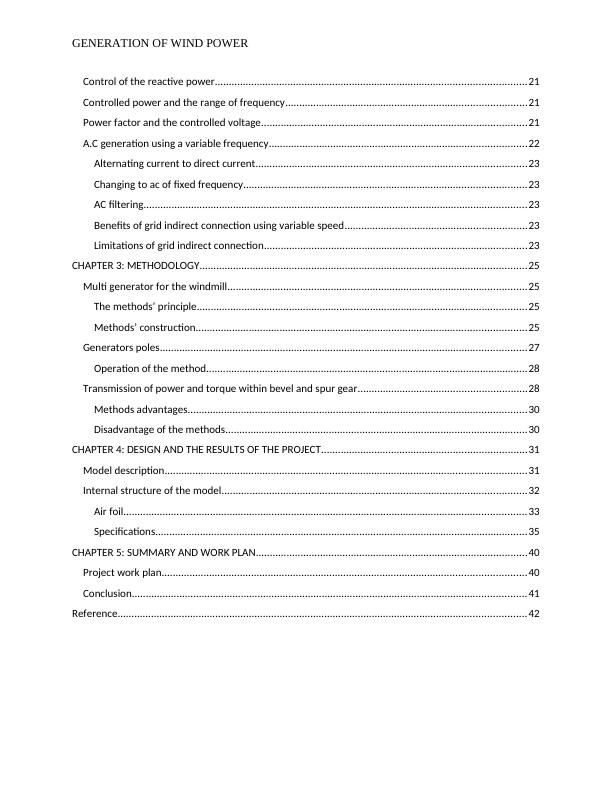
GENERATION OF WIND POWER
ABSTRACT
The device which changes energy of kinetic from the moving air to energy of mechanical is
known as wind turbine. The equipment can sometimes be referring to as wind generator or wind
charger when energy of mechanical is applied in electrical generation. Currently the
manufactures of turbines manufacture wind turbines in a range of horizontal and vertical axis
kinds. Basically these manufactured turbines are applied for different functions. Wind energy
being used for the power generation is thought to the one of the best efficient and clean energy in
the current world (Wendler et al., 2016). It is because this energy has no pollution to the
surrounding, has no hazard and is a renewable source for the generation of electric power. This
report focuses on the wind power and its ability to be controlled in the coming time to supply the
current energy required. Applying generators and wind turbine in generating power has been
given on the interconnections of the producers with the grid and the challenges occurred when
the method is used. There has been also the emphasis of using the power electronics in the
circuitry and their uses. Using of multi-generators to can as well be employed to overcome the
problem of reliability, cost and dimension. Sharing of one shaft via straight bevel gears can be
required when double electromagnetic induction generators are used (Saverin et al., 2016).
Changing from alternate to parallel position of the poles of the two generators will be a
condition. In the research there is a discussion of the gears procures of the design, gear life and
rotors of the wind turbine. Using converter and step up transformer, an output current to the
appliances is stored in series of battery. The other discussed parts in the paper are the
construction, operation, windmill parts and the materials.
ABSTRACT
The device which changes energy of kinetic from the moving air to energy of mechanical is
known as wind turbine. The equipment can sometimes be referring to as wind generator or wind
charger when energy of mechanical is applied in electrical generation. Currently the
manufactures of turbines manufacture wind turbines in a range of horizontal and vertical axis
kinds. Basically these manufactured turbines are applied for different functions. Wind energy
being used for the power generation is thought to the one of the best efficient and clean energy in
the current world (Wendler et al., 2016). It is because this energy has no pollution to the
surrounding, has no hazard and is a renewable source for the generation of electric power. This
report focuses on the wind power and its ability to be controlled in the coming time to supply the
current energy required. Applying generators and wind turbine in generating power has been
given on the interconnections of the producers with the grid and the challenges occurred when
the method is used. There has been also the emphasis of using the power electronics in the
circuitry and their uses. Using of multi-generators to can as well be employed to overcome the
problem of reliability, cost and dimension. Sharing of one shaft via straight bevel gears can be
required when double electromagnetic induction generators are used (Saverin et al., 2016).
Changing from alternate to parallel position of the poles of the two generators will be a
condition. In the research there is a discussion of the gears procures of the design, gear life and
rotors of the wind turbine. Using converter and step up transformer, an output current to the
appliances is stored in series of battery. The other discussed parts in the paper are the
construction, operation, windmill parts and the materials.
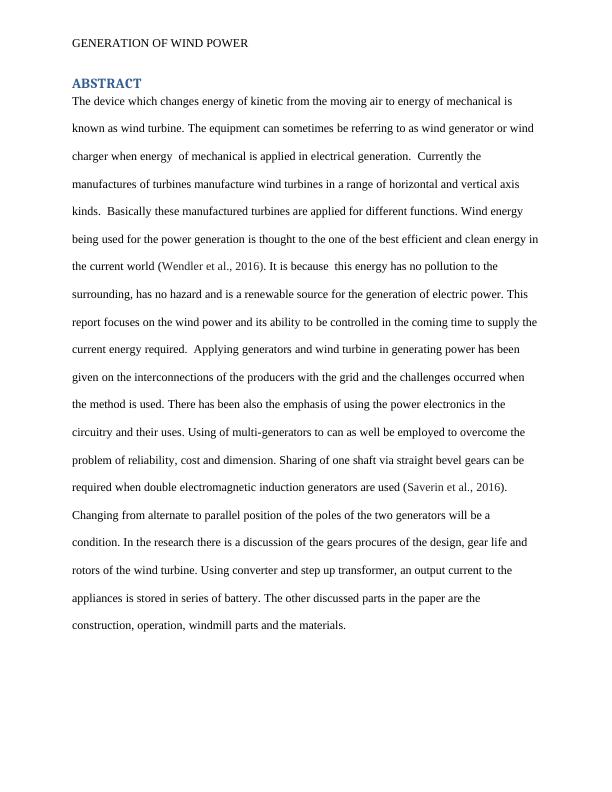
GENERATION OF WIND POWER
CHAPTER 1: INTRODUCTION
Sources of energy which don’t get damaged during the harnessing of the energy are called
renewable sources (Dal Monte et al., 2013). They include flow of water, wind, light from sun,
waves, geothermal heat, activities of biology such as anaerobic digestion as well as production of
biological hydration. They all require the use of technology for their conversion. Wind energy
among the above listed energy sources is having a lot of growth for harnessing of its energy
through the use of the technology.
The motion of air masses which are generated through uniform heating of the earth’s
surface using the sun is called wind (Adams et al., 2011). This variation then builds up forces
which push the surrounding masses of air for neutralizing the temperature of earth (sea together
with land’s temperature or mountain for smaller scale).
The energy from wind as a source lacks the condition of being stable or constant. There is
frequent variation and it gives energy while bursting. During its 15% of its working time, it can
give out up to 50% of its whole energy (Farthing., 2010). Continuous power cannot be assured
sine the strength of the wind changes. It is therefore important to be applied in the system
combination that are capable of reserving like stored or hydro load like plant of desalinization, so
that there can be resource variability of economic impacts can be mitigated.
Wind power generated can be calculated using the formula below:
Power (w) = 0.5 × p × π × r3 × vw3 × cp × (λ, ẞ)
Where, power (w) =power generated from the wind energy,
P=density of air, which is assumed to be 1.2kgm-3,
CHAPTER 1: INTRODUCTION
Sources of energy which don’t get damaged during the harnessing of the energy are called
renewable sources (Dal Monte et al., 2013). They include flow of water, wind, light from sun,
waves, geothermal heat, activities of biology such as anaerobic digestion as well as production of
biological hydration. They all require the use of technology for their conversion. Wind energy
among the above listed energy sources is having a lot of growth for harnessing of its energy
through the use of the technology.
The motion of air masses which are generated through uniform heating of the earth’s
surface using the sun is called wind (Adams et al., 2011). This variation then builds up forces
which push the surrounding masses of air for neutralizing the temperature of earth (sea together
with land’s temperature or mountain for smaller scale).
The energy from wind as a source lacks the condition of being stable or constant. There is
frequent variation and it gives energy while bursting. During its 15% of its working time, it can
give out up to 50% of its whole energy (Farthing., 2010). Continuous power cannot be assured
sine the strength of the wind changes. It is therefore important to be applied in the system
combination that are capable of reserving like stored or hydro load like plant of desalinization, so
that there can be resource variability of economic impacts can be mitigated.
Wind power generated can be calculated using the formula below:
Power (w) = 0.5 × p × π × r3 × vw3 × cp × (λ, ẞ)
Where, power (w) =power generated from the wind energy,
P=density of air, which is assumed to be 1.2kgm-3,
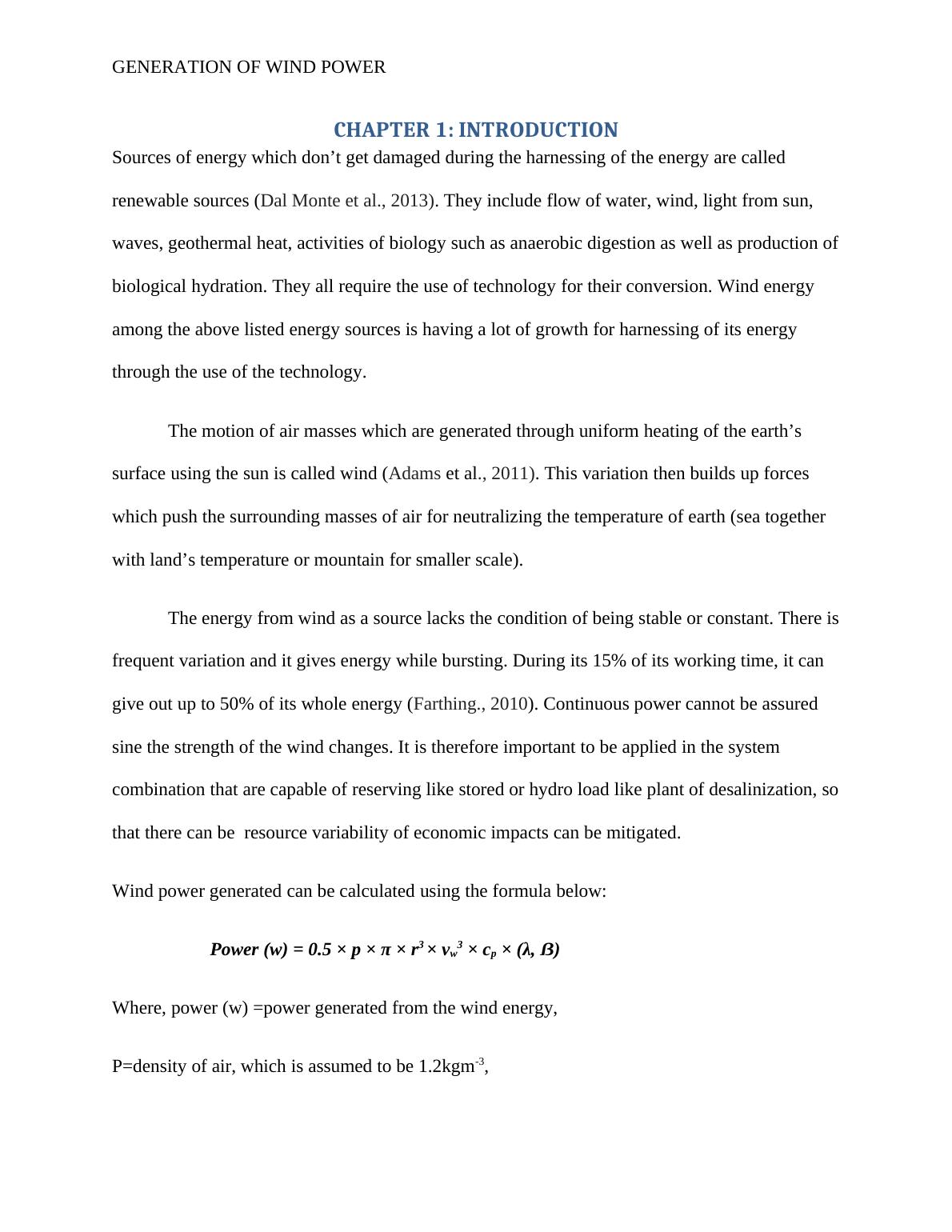
GENERATION OF WIND POWER
r= radius of the blade, measured in meters and ranges from 40m to 60m,
vw=speed of wind, measured in meters per second and be controlled from 3m/s to 30m/s,
cp =the coefficient of power ,which is the speed ratio function(λ) and pitch blade angle(ẞ). This
is an output power generated ratio to the present power from wind.
Graph below shows a relationship between the coefficient of power and tip ratio speed.
Betz limit: it is the highest theoretical value of power for every wind turbine (Vennell., 2013).
There is no availability of wind turbine that can be used to convert kinetic energy of wind that
exceeds 59.3% to mechanical energy while rotating a rotor. The highest coefficients of the good
wind turbines as per the Betz limit always range from 34% to 45%. The ratio between speed of
r= radius of the blade, measured in meters and ranges from 40m to 60m,
vw=speed of wind, measured in meters per second and be controlled from 3m/s to 30m/s,
cp =the coefficient of power ,which is the speed ratio function(λ) and pitch blade angle(ẞ). This
is an output power generated ratio to the present power from wind.
Graph below shows a relationship between the coefficient of power and tip ratio speed.
Betz limit: it is the highest theoretical value of power for every wind turbine (Vennell., 2013).
There is no availability of wind turbine that can be used to convert kinetic energy of wind that
exceeds 59.3% to mechanical energy while rotating a rotor. The highest coefficients of the good
wind turbines as per the Betz limit always range from 34% to 45%. The ratio between speed of

GENERATION OF WIND POWER
the rotating tip of blade and the real wind’s speed is known as the tip speed ratio (λ). The speed
tip ratios of high quality three blade turbines ranges from six to seven. The highest capacity of
the wind power that can be controlled is about 72 TW. Currently many countries are operating
with wind turbines with the companies consuming an overall amount of 59,322 MW. Initially by
2007, total capacity of the generated power through wind energy was 94.1 GW which was 1% of
the world total power produced.
The exploitation of the existing wind energy is done through designing of wind turbines.
Finding the appropriate height of the tower, control system, quantity of blades as well as their
shape is done using an aerodynamic modeling. Turbines change the wind energy to the
distributed electrical energy (Lynn., 2011). Horizontal axis turbines could be categorized into 3
groups as follows; turbine with a rotor element that is almost twenty percent of the cost of
turbine having converted wind energy from blades to energy of less rotational speed, the gearbox
and control electronics element used for changing incoming rotation of less speed to rotation of
high speed. There is existence of the electrical generator plus the major rotor shaft in the HAWT
on the uppermost part of a tower which should face wind. A wind vane is purposed to point wind
direction for the small turbines while a wind sensor integrated with a servo motor is employed
for large turbines. Most of these sensors contain a gearbox that changes speed from slower
yawing to a higher speed rotation which is appropriate in moving electrical generator.
Arrangement of these blades is in good order in the tower suitable for good rotational speed of
wind. Some of these turbines work with a constant velocity allowing more energy to be
generated through variable-speed turbines that is using a power state of solid converter to
interface to system of transmission.
the rotating tip of blade and the real wind’s speed is known as the tip speed ratio (λ). The speed
tip ratios of high quality three blade turbines ranges from six to seven. The highest capacity of
the wind power that can be controlled is about 72 TW. Currently many countries are operating
with wind turbines with the companies consuming an overall amount of 59,322 MW. Initially by
2007, total capacity of the generated power through wind energy was 94.1 GW which was 1% of
the world total power produced.
The exploitation of the existing wind energy is done through designing of wind turbines.
Finding the appropriate height of the tower, control system, quantity of blades as well as their
shape is done using an aerodynamic modeling. Turbines change the wind energy to the
distributed electrical energy (Lynn., 2011). Horizontal axis turbines could be categorized into 3
groups as follows; turbine with a rotor element that is almost twenty percent of the cost of
turbine having converted wind energy from blades to energy of less rotational speed, the gearbox
and control electronics element used for changing incoming rotation of less speed to rotation of
high speed. There is existence of the electrical generator plus the major rotor shaft in the HAWT
on the uppermost part of a tower which should face wind. A wind vane is purposed to point wind
direction for the small turbines while a wind sensor integrated with a servo motor is employed
for large turbines. Most of these sensors contain a gearbox that changes speed from slower
yawing to a higher speed rotation which is appropriate in moving electrical generator.
Arrangement of these blades is in good order in the tower suitable for good rotational speed of
wind. Some of these turbines work with a constant velocity allowing more energy to be
generated through variable-speed turbines that is using a power state of solid converter to
interface to system of transmission.
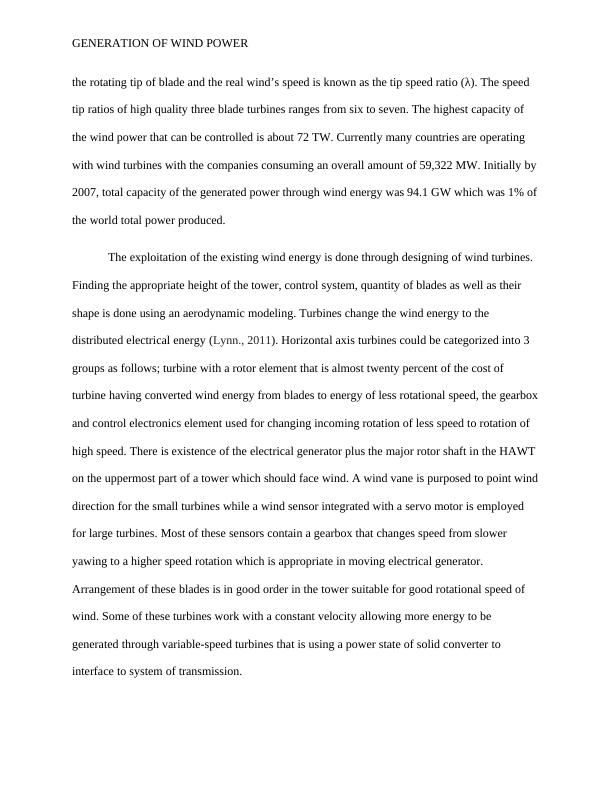
GENERATION OF WIND POWER
Upward and downward turbines
For prevention of the turbines’ destruction at winds’ higher speeds, they are equipped with the
protective features through streamlining the blades within the wind stopping their movement
added using brakes. To ensure that downwind machine has the reduced sweeping area caused by
high winds allowing blades to bend which then reduces the wind resistance, they have been built
in such a way that despite of the turbulence challenge, they do not require a mechanism which is
added that alogns them with the wind. Many horizontal axis wind turbines (HAWT) have
upward shape or appearance because of the repetitive turbulence which can result to fatigue
failures. The upward design of the HAWT is provided in this paper.
Windmill’s rotary movement is used for turning of an electric generator in order to
produce electricity. The power given by one windmill is a bit small and cannot be enough for
either commercial or industrial users. This can then be eliminated through erecting several
windmills over a vast surface that is referred to as energy wind farm. All these windmills erected
are coupled together to generate electricity enough for both commercial and industrial uses. The
Upward and downward turbines
For prevention of the turbines’ destruction at winds’ higher speeds, they are equipped with the
protective features through streamlining the blades within the wind stopping their movement
added using brakes. To ensure that downwind machine has the reduced sweeping area caused by
high winds allowing blades to bend which then reduces the wind resistance, they have been built
in such a way that despite of the turbulence challenge, they do not require a mechanism which is
added that alogns them with the wind. Many horizontal axis wind turbines (HAWT) have
upward shape or appearance because of the repetitive turbulence which can result to fatigue
failures. The upward design of the HAWT is provided in this paper.
Windmill’s rotary movement is used for turning of an electric generator in order to
produce electricity. The power given by one windmill is a bit small and cannot be enough for
either commercial or industrial users. This can then be eliminated through erecting several
windmills over a vast surface that is referred to as energy wind farm. All these windmills erected
are coupled together to generate electricity enough for both commercial and industrial uses. The
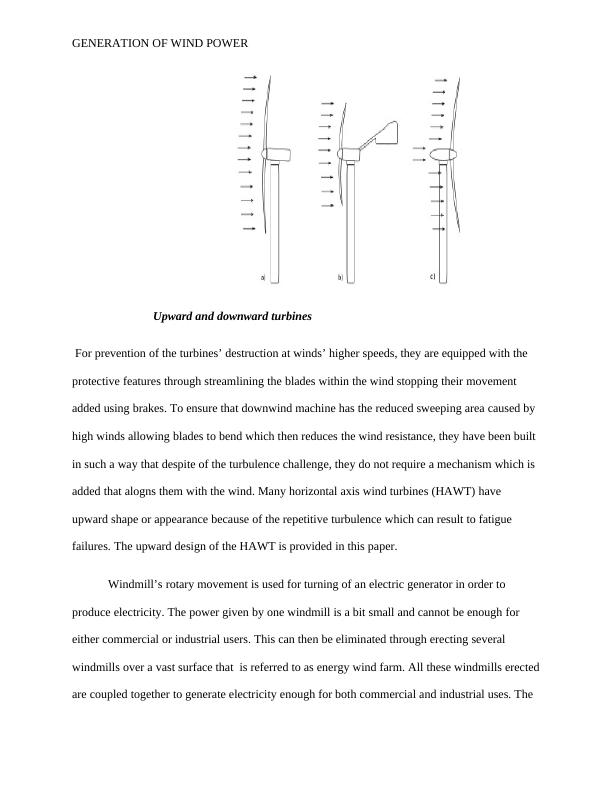
End of preview
Want to access all the pages? Upload your documents or become a member.
Related Documents
Advance Electrical Machines and Driveslg...
|39
|6447
|5
Wind Turbine Aerodynamic Theory and Simulationlg...
|37
|10501
|443
IMPROVE WIND POWER GENERATIONlg...
|22
|5834
|193
Report on Short Circuit Calculations in Networkslg...
|75
|13475
|38
Advanced Power Quality: Wind Turbines and DFIGlg...
|39
|7105
|57
Wind Turbines Induction Generators (Doc)lg...
|14
|2434
|679
